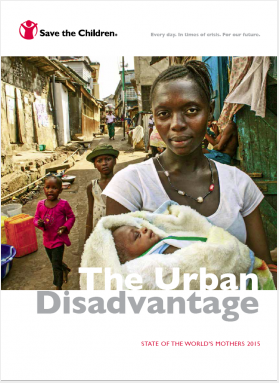
Cities still failing poor urban kids, says new global health report
11 May 2015
by Richard Forster
Save the Children’s new report, State of the World’s Mothers 2015: The Urban Disadvantage, reveals that national and urban health figures are not as glossy as first seem with many a child’s survival in cities dependent on family wealth.
“Our new report reveals a devastating child survival divide between the haves and have-nots, telling a tale of two cities among urban communities around the world, including the United States,” said Carolyn Miles, president and CEO of Save the Children. “For babies born in the big city, it’s survival of the richest.”
The report presents a first-ever global assessment of health disparities between rich and poor in cities. It has identified that many cities are unable to keep up with the breakneck pace of urban growth, leaving one-third of all urban residents–including hundreds of millions of mothers and children–to live in slums, where a lack of clean water, basic sanitation and health services can equal death.
Yet, average national and urban child survival statistics tell a deceptively positive story. They show that in developing nations children living in big cities are surviving at higher rates than those living in smaller towns or rural areas. But these numbers mask the fact that a child’s survival in the city too often is dependent on the family’s wealth.
Save the Children’s report reveals:
- In two-thirds of the countries surveyed, the poorest urban children are at least twice as likely to die as the richest urban children.
- The disparity in child survival rates between the rich and poor in urban areas has widened over roughly the past two decades in nearly half of the 40 developing nations surveyed.
According to the report, in 60 percent of developing nations surveyed, city children living in poverty are more likely to die than those living in rural areas.
The gap between the health of the rich and poor is just as prevalent in big cities in some of the wealthiest nations. In Washington DC for example, babies in the lowest income neighbourhood are more than 10 times more likely to die than babies in the wealthiest part of the city.
In a ranking of child survival in 25 capital cities in the wealthiest countries, the US capital came in last. Joining Washington DC at the bottom of the list are: Vienna (Austria), Bern (Switzerland), Warsaw (Poland) and Athens (Greece).
Leading the list of capitals where babies are most likely to survive are: Prague (Czech Republic), Stockholm (Sweden), Oslo (Norway), Tokyo (Japan) and Lisbon (Portugal).
However, the report has also uncovered some good news. It has identified a number of cities that are making significant gains for the poorest children, including Addis Ababa (Ethiopia); Cairo (Egypt); Guatemala City (Guatemala); Kampala (Uganda); Manila (Philippines); and Phnom Penh (Cambodia). These cities are working to increase access to basic maternal, newborn, and child services; raise health awareness; and make care more affordable and accessible to the poorest urban families.
“The survival of millions of children in cities should not be a privilege for the rich, but guaranteed for all,” added Miles. “We call on our leaders not to forget these mothers and children struggling to survive in the shadows of our bustling metropolises. We must invest in making quality health care more accessible and affordable to all mothers and babies.”








